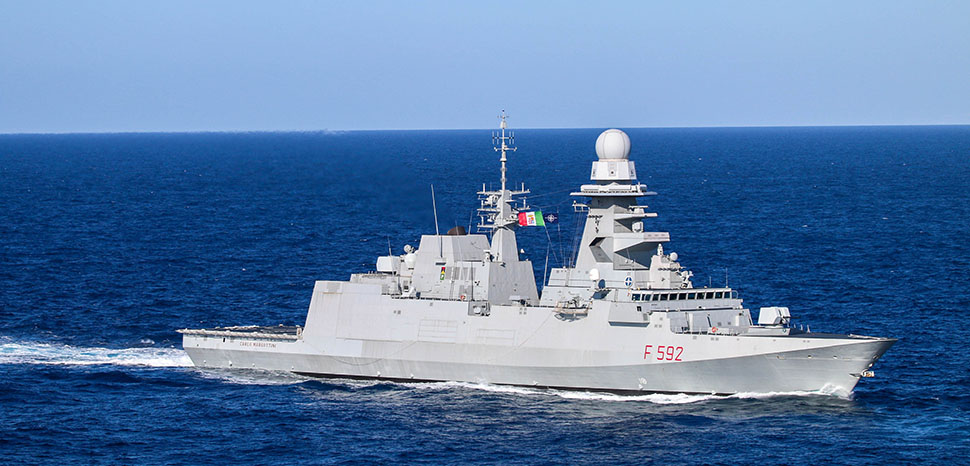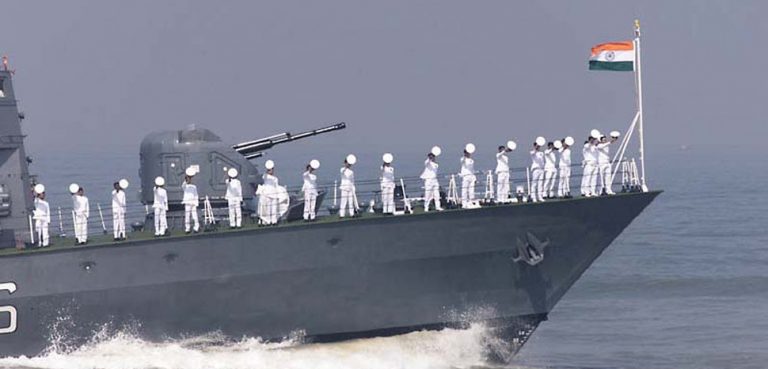Addressing Italy’s geopolitical performance objectively is certainly not a rewarding exercise or a herald of optimistic prospects. Nonetheless, identifying the core constraints of Italy, juxtaposing it with other regional and international players, and setting its quantitative and qualitative potential in an overall framework will allow us to avoid facile pessimism, albeit justified. This analysis shall focus on international and diplomatic ties, with sea trade and demographics as key factors to a state’s relative power and status.
This part of the century has so far seen Italy firmly anchored in the Western camp, more specifically in the American sphere of influence, and uneasily afloat in the Mediterranean area. Within these two poles – one of political significance, the other a tangible physical area – Italy exists and acts. Although the common feeling and international aspirations among Italians is just to imagine their nation being a first-rate member of the European Union, the reality should prompt a recognition of themselves as a pivotal player in the Mediterranean area. Since Unification, in this geographical arena, Italy has prided itself on an enviable central position straddling two narrow straits – that of Sicily and of Otranto – which lead from the Indo-Pacific via Suez to the hyper-productive heart of Europe. Along these routes around the Eurasian rimland, Italy continues to benefit from the near-optimal locations of gateway shipping ports to the Central European area such as Genoa and Trieste. The prosperity hitherto enjoyed by Italians lies not only in extraordinary production and technical capabilities, albeit those of a processing economy that procures nearly all its raw materials abroad. The security of its routes and supplies is also a sure product of globalization, guaranteed by US naval supremacy.
As the Cold War geopolitical rules seemed to wane, the Italian economistic approach to international affairs led to a diplomatic faux pas in the late 2010s. Having laboriously resurfaced after years of the post-2008 recession, the signing of the Silk Road Memorandum in 2019 as part of the Belt and Road Initiative (BRI) with the People’s Republic of China had misled Italian governments into thinking that globalization and its fruits were ‘duty-free.’ Almost immediately caught out and forced to renege those agreements, which included Chinese investments in strategic features such as 5G-telecommunications, ports, and aerospace industry, Italy was reminded by the United States of its obligations and, indirectly, of its auxiliary role within Washington-led world order. In the same decade, the Arab Springs of 2011 and the British-French-led NATO intervention plunged the North African shore into chaos, almost ousting Italy from its relationship with its largest energy partner, Libya. The ensuing civil war caused numerous rifts among which powers like France, Turkey, Russia, the Gulf countries advanced their opposing or overlapping agendas. The NATO membership of the first two created a further contradiction: unable to shoot at each other, under penalty of a backlash from the dominant power, a proxy war began between these rowdy satellites, each supporting the warring governments of Tripoli and Misurata with diplomatic and military means. On the Libyan battleground, the Emirates’ funding and support of militias and the appearance of Russian private military companies only worsened Italy’s precarious situation, and this in a country where it was hitherto more effective to display the six-legged dog logo of Eni, the Italian state-owned oil company, rather than the tricolor flag as a guarantee of national energy interests.
What once appeared to be a momentous phenomenon beginning with the Arab Spring(s), bringing dramatic repercussions for the lives of local populations and the Mediterranean region as a whole, was eventually scaled down in the broader perspective of the ’21st-century clash’ between the United States and China. President Obama’s pivot to Asia had, as a corollary, Washington tolerating conflicts at the borders of its sphere of influence, leaving its allies to manage side effects. China itself was able to penetrate those latitudes by coaxing and framing Morocco, Algeria, Tunisia, Libya, Egypt, and Israel in terms of BRI trade routes. Although this scenario continues to make the Suez Canal a vital node, from the opening and affordability of which Italy benefits too, the People’s Republic’s schemes toward counter-globalization have the potential of downgrading this main shipping route to a secondary one due to its efforts to co-opt and attract sub-Saharan African countries while attempting to open Arctic routes only recently made navigable by the melting of the polar ice cap. The future percentage of trade moving through the Suez Canal could then fall well below today’s 12% of world volumes.
In the shipping sector, Italy can still claim a fair amount of dynamism among the players in the Mediterranean basin, as is illustrated by comparing some shipping indicators of ports and the merchant fleet. In view of the rationalization of Italy’s port system following the reforms of 2016, Italian ports – mainly Gioia Tauro, Cagliari, and Taranto – show a good capacity for trans-shipment despite being disadvantaged by hinterlands that do not always provide adequate standards in terms of rail and road connectivity. A comparison of international logistics indices places Italy in the top two positions in port-system performance and integration, with said indices specifically reflecting customs efficiency, infrastructure, timing, and number of ports of call. Were it not for the Atlantic-facing advantage that Spain and France enjoy, Italy’s position would be even more prominent (see Figures 1-5).
As far as fleet sizes are concerned, the Italian merchant marine itself ranks sixteenth in the world in terms of value in USD and second in the Mediterranean basin after the Greek ‘superpower’ with a predominance of cruise ships, oil tankers and cargo vessels.

(Figure 1) Primary and secondary trade routes and Port LSCI indices. The concentration of ports with LSCI of more than 25 along the Italian coast is noteworthy.

(Figure 2) Number of container ship port calls and average tonnage in TEUs per country.

(Figure 3) Logistics Performance Indexes (LPI) of the major Mediterranean Sea countries. The LPI is the result of six factors: customs, infrastructure, ease of organizing shipments, logistics service quality, traceability, and timeliness.

(Figure 4) LSCI indices of the major Mediterranean Sea countries. The LSCI index is the result of six factors: number of port calls, TEU-receiving capacity, number of routes to and from the country, number of shipping companies to and from the country, average vessel size in TEUs, and number of countries connected to the country through direct port calls.

(Figure 5) Registered ships of main Mediterranean Sea countries; ships over 100 gross-tons.
These patterns are destined to last in the years to come even though trends are moving towards an increase in global tonnage concentrated in fewer ships of increasing tonnage (Very Large Crude Carriers and Ultra Large Container Vessels), a phenomenon that would see Italian ports with shallower draughts at a loss compared to North African and Near East ports. By contrast, the recent trends in reshoring and near-shoring of the supply chain that have emerged in the wake of the Ukraine war and the tensions in the South China Sea may shift trade routes in the Mediterranean more towards short-shipping with European ports as well as with those on the North African coast. Increasingly, countries such as Morocco, Algeria and Egypt are seeing industrial clusters flourish that are oriented towards engineering and light industry and integrate with European manufacturing.
If maritime fundamentals make Italy a major player, this is despite the general and substantial unawareness of the population in this regard, which is at most inclined to nurture unrealistic desires for prosperity, to pursue in the European vein. Italian public discourse urges the country to be on a par with the northern economies, overtaking, in civil and political rights, those countries that Italians refer to as the ‘normal’ ones. On the contrary, downplaying what happens beyond the Brenner Pass would help Italy embracing a maritime culture: a community that truly feels Mediterranean will focus all its energies in competing and succeeding with regional players. Figure 6 takes a quantitative and qualitative snapshot of those energies and projects them to 2030: Italy’s population is estimated to decrease by 2 million, albeit offset by more immigration, the percentage of young people will fall by 1%, and the median age will rise to 50.3 years. Projections to 2040 foresee the percentage of over-65s rise to over 30%. The effects on the population will be dramatic: the demographic imbalance will disadvantage Southern Italy, one-person households will exceed 10 million, and the ratio of workers to retirees will fall to less than two. This unprecedented increase in the elderly population will affect consumption patterns, the demand for care services, family roles, and the geometry of public spending. The Italian cultural and anthropological identity itself could change forever: the price for maintaining a semblance of a reasonable median age would be through migratory transfusion.
Though the megatrends regarding the demographic slowdown taking place in developed countries during 21st century have been known for a long time, the case of Italy stands out for its proximity to the only major European country going against the trend, France, and for its positioning on a fault line with the continent, Africa, which, by the end of this century, will host the greatest concentration of under-29 human beings in history. Countries such as Algeria and Egypt will increase in numbers, despite emigration, and maintain a median age of less than 30 years. Similarly, Turkey will see its demographic curve rising and its young population increase steadily. France, Turkey, Egypt, and Algeria, lining the four quadrants of the Mediterranean, are already pushing seawards, stretching their landward offshoots towards the 200-miles median line, claiming exclusive economic zones (EEZs) that are not always internationally recognised, targeted at rich and untapped offshore energy resources (see Figure 7).
This thirst for energy is echoed by growing food insecurity, which is the result of climate change as much as of external causes such as the Ukraine war. The trend can only worsen in dry, developing countries in the Sahel strip and North African shore like Algeria and Egypt, being the recipients of almost 22% of Ukraine’s cereal exports. The spasmodic search for primary resources in a crowded Mediterranean comes along with an ever-increasing militarisation of the basin: the national fleets of formerly minor states have started modernizing assets and showing their flags to the west and east (see Table 1). Although thinning out from the Cold War ‘splendor’, the Italian Navy still deploys a well-balanced potential of modern ocean-going vessels, second only to France, that also endures worldwide commitments. Today’s Turkish and Egyptian navies show themselves as looming threats, yet not directly hostile to Italy. Given the numerous, sometimes ill-concealed or implicit disputes between states bordering the eastern Mediterranean, Turkey-Greece, and Turkey-Egypt among the hottest, the greatest danger lies in the unleashing of any armed conflict, even of only short duration. The immediate effect would be a limiting or, worse, a blockade of merchant shipping, on which, as mentioned above, Italy depends. Also, the offshore extraction installations located near disputed or crowded EEZs, as is the case in the eastern Mediterranean Leviathan gas fields, become sensitive targets. A scenario is not so far-fetched, especially considering that the hegemonic attention of the United States will be on the Pacific, where an asymmetrical, self-destructive war is unleashed between states that consider themselves the owners of their respective choke points, Marmara and Suez, under a mutual illusion of being able to defeat each other. Tending to naval hardware and personnel skills will be key for Italy in deterring threats for the next decade: a need coped with steady increases in the latest naval budgets (increased 200 million € in 2023) to acquire new weapon systems such as Thaon di Revel class multi-purpose patrol vessels.

(Table 1) Fleet comparison of the major Mediterranean Sea countries. Note: * Horizon-class destroyer, † FREMM-class frigate, Franco-Italian design, and building.
Throughout the 21st century, Italy will continue to benefit from its enviable position not found in, or comparable to, any other of the countries bordering the world’s other ‘Mediterranean’ seas (Caribbean, South China Sea, Baltic). Its geography and shape, like a magnet stretching to the southeast to intercept terminal routes from the Far East, is complemented by objective maritime data (port system, merchant, and military fleet); its southward elongation allows current governments envisaging the peninsula as an energy hub for Saharan and Azeri gas pipelines. Italy’s greatest encumbrance in the coming years will be its most inherently human factor: an ageing nation experiencing a regional trend of its neighbors increasingly eroding its interests abroad, and endangering its vital seaborne supplies and exports; its national wealth will be funneled into supporting the necessary welfare needs of a growing elderly population; its sizeable public debt held by non-resident institutions (26.9%), difficult to buy back through extraordinary taxation, will become consolidated as an external constraint. Under pressure internationally and from the Mediterranean’s assertive regional players, Italy’s overriding imperative will be to maintain, or possibly increase, its advantageous position. While it will prove impossible to act in a confrontational manner, due to a geographical centrality that might expose in to attacks from several directions, Italy is destined to mediate between the most revisionist and assertive competitors, France, Turkey and Algeria, especially regarding heated issues such as gas extraction in Libya and contested EEZs; support those who draw nourishment from its own straits, such as Greece and Egypt; and integrate new shorter logistical chains with those in need of technical professionalism and capacity, notably Egypt. Such is the narrow path through which Italy, a sidelined piece of the Mediterranean jigsaw, could hope to succeed in compensating for its outlines, and fit into the overall puzzle.

(Figure 6) Demographic statistical data of Mediterranean ‘heavyweights’, year 2020 and 2030.

(Figure 7) Mediterranean geopolitics of Italy. Sea routes, ports, choke points, pipelines, EEZs, foreign missions and sphere-of-influence conflicts in 2023.





